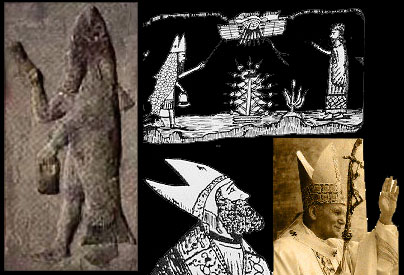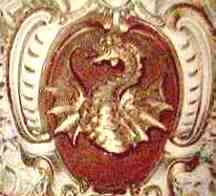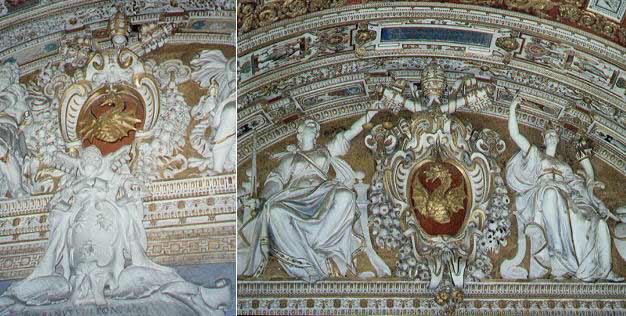| |
Pagan Babylon worshipped the sun as a deity, and pagan Rome also worshipped the sun. The Roman Catholic Church, with the assistance of Constantine, changed the day of worship from Sabbath to Sun Day and commonly used images and symbols of the sun. Constantine placed no Christian appellation
upon the worship on the first day of the week, referring
to it as the "venerable day of the sun."
Let all judges and all city people and all tradesmen rest upon the venerable day of the sun. But let those dwelling in the country freely and with full liberty attend to the culture of their field; since it frequently happens that no other day is so fit for the sowing of grain or the planting of vines; hence, the favorable time should not be allowed to pass, lest the provisions of heaven be lost. Quoted in Blakely, p. 269
Or if you prefer the Codex Justinianus:
On the venerable Day of the Sun let the magistrates and people residing in cities rest, and let all workshops be closed. In the country, however, persons engaged in agriculture may freely and lawfully continue their pursuits; because it often happens that another day is not so suitable for grain-sowing or for vine-planting; lest by neglecting the proper moment for such operations the bounty of heaven should be lost. (Given the 7th day of March, Crispus and Constantine being consuls each of them for the second time [A.D. 321].) Source: Codex Justinianus, lib. 3, tit. 12, 3; trans. in Philip Schaff, History of the Christian Church, Vol. 3 (5th ed.; New York: Scribner, 1902), p. 380, note 1.
Below on the left is a Neo-Assyrian
standing stone (stele/stela) dating from about 824-811 B.C.,
which depicts King Shamshi-Adad V. Note the
necklace the King is wearing. On it is what today is called
a Maltese cross. Twenty-eight hundred years ago that shape
was symbolic of pagan sun worship.
Clicking on the above image will take you to the British Museum. Today the Pope wears a similar symbol around his neck, on the Pallium, which the Pope also confers on selected bishops as an ornamental token of his favor, and it is also worn by archbishops and patriarchs as a symbol of their authority as a metropolitan, derived from unity with the Pope. The Pope also has a ring and staff of authority, remarkably similar to the depiction of the sun god Shamash on the Babylonian tablet shown previously. Note the lower hand of King Ashur-nasir-pal II in the above stele. On the wrist is the sunburst symbol. On the right, the pagan sunburst is on the glove of Pope John XXIII. Clicking on the image of the stele will take you to the British Museum.
The depictions of the pagan kings on
the ancient standing stones (stela) above, show a strip
of cloth (lappet) hanging from the rear of the headgear.
These lappets are also present on the papal mitre and tiara,
shown at left, and partially visible in the photos of popes
above.
 The
fish-like form was a symbol of fruitfulness, and as such was likely
to be adopted by seafaring tribes in the representation of their gods,
which is why Rome who ruled the seas easily adopted the mystery religion
from the Philistines. Here we see carvings and diagrams of Dagon
priests and their fish head hats along side the Pope with his similar
fish head hat. The carving on the left shows the Dagon priests sprinkling
holy water.
The
fish-like form was a symbol of fruitfulness, and as such was likely
to be adopted by seafaring tribes in the representation of their gods,
which is why Rome who ruled the seas easily adopted the mystery religion
from the Philistines. Here we see carvings and diagrams of Dagon
priests and their fish head hats along side the Pope with his similar
fish head hat. The carving on the left shows the Dagon priests sprinkling
holy water.
 Revelation 17
Revelation 171 And there came one of the seven angels which had the seven vials, and talked with me, saying unto me, Come hither; I will shew unto thee the judgment of the great whore that sitteth upon many waters: 2 With whom the kings of the earth have committed fornication, and the inhabitants of the earth have been made drunk with the wine of her fornication. 3 So he carried me away in the spirit into the wilderness: and I saw a woman sit upon a scarlet coloured beast, full of names of blasphemy, having seven heads and ten horns. 4 And the woman was arrayed in purple and scarlet colour, and decked with gold and precious stones and pearls, having a golden cup in her hand full of abominations and filthiness of her fornication: 5 And upon her forehead was a
name written, MYSTERY, BABYLON THE GREAT, THE MOTHER OF HARLOTS
AND ABOMINATIONS OF THE EARTH.
6 And I saw the woman drunken with the blood of the saints, and with the blood of the martyrs of Jesus: and when I saw her, I wondered with great admiration. 7 And the angel said unto me, Wherefore didst thou marvel? I will tell thee the mystery of the woman, and of the beast that carrieth her, which hath the seven heads and ten horns. 8 The beast that thou sawest was, and is not; and shall ascend out of the bottomless pit, and go into perdition: and they that dwell on the earth shall wonder, whose names were not written in the book of life from the foundation of the world, when they behold the beast that was, and is not, and yet is. 9 And here is the mind which hath wisdom. The seven heads are seven mountains, on which the woman sitteth. Daniel 7 I think the blasphemies are 'false doctrine'. Changing the Sabbath to Sun-day, in honor of the 'venerable day of the sun', changes YHWH's Law regarding the 4th Commandment. The biblical calendar has been around since the beginning. It was given to all mankind. The Babylonians used it. When the exile ended the Jews brought it with them. This is why the Jewish calendar has Babylonian names for the months. But, the papacy changed all that with the introduction of the Julian calendar, which was later revised and became the Gregorian calendar. Under the Gregorian calendar, the New Year is changed and is no longer in the spring as G-d/YHWH commanded. Passover was changed to Easter and of course the Sabbath was changed to SUN day. That, along with starting the "day" at midnight, made their "change of times and seasons" complete.
Exodus 12 This was commanded by YHWH to Moses at the time of the Passover, which always comes in spring. In accordance with its ancient beginnings (right from The Seven Days Of Creation when light was created after the darkness), Bible calendar days were, and are, determined to begin and end at sunset e.g "from evening to evening shall you keep your sabbath" (Leviticus 23:32 ) Genesis 1 Leviticus
23 The Popes/RCC have fulfilled
Daniel 7:25, the 4th beast of verse 23.
Deu 17:3 And hath gone and served other
gods, and worshipped them, either the sun, or moon, or
any of the host of heaven, which I have not commanded;
The Roman Catholic Church even admits
the Monstrance to be a sunburst:
"During the baroque period, it took on a rayed form of a sun-monstrance with a circular window surrounded by a silver or gold frame with rays."
Revelation 13
1 And I stood upon the sand of the sea, and saw a beast rise up out of the sea, having seven heads and ten horns, and upon his horns ten crowns, and upon his heads the name of blasphemy. 2 And the beast which I saw was like unto a leopard, and his feet were as the feet of a bear, and his mouth as the mouth of a lion: and the dragon gave him his power, and his seat, and great authority. Daniel 7 25 And he shall speak great words against the most High, and shall wear out the saints of the most High, and think to change times and laws: and they shall be given into his hand until a time and times and the dividing of time.  Pope Gregory XIII came up with
the Gregorian calendar, it was through the Catholic church/Constantine
that the 4th Commandment regarding the Sabbath was changed. (Changing
one of YHWH's Laws) Interestingly enough, at least
two popes used a dragon on their shield and one of them just happens
to be Pope Gregory XIII.
Pope Gregory XIII came up with
the Gregorian calendar, it was through the Catholic church/Constantine
that the 4th Commandment regarding the Sabbath was changed. (Changing
one of YHWH's Laws) Interestingly enough, at least
two popes used a dragon on their shield and one of them just happens
to be Pope Gregory XIII.(The picture at the left depicts the coat of arms of Gregory XIII. This is one of two that can be found above the doors in the Gallery of Maps, in the Vatican.) Revelation 13 3 And I saw one of his heads as it were wounded to death; and his deadly wound was healed: and all the world wondered after the beast. 4 And they worshipped the dragon which gave power unto the beast: and they worshipped the beast, saying, Who is like unto the beast? who is able to make war with him? 
Rev 17:4 And the woman was arrayed in purple and scarlet colour, and decked with gold and precious stones and pearls, having a golden cup in her hand full of abominations and filthiness of her fornication:
Rev 18:3 For all nations have drunk of the wine of the wrath of her fornication, and the kings of the earth have committed fornication with her, and the merchants of the earth are waxed rich through the abundance of her delicacies. The image coming up is a close up of
one of three sets of coins issued by the Vatican.
Incredibly enough, the woman representing faith (the Catholic
Church) on the reverse side of the coins holds up a cup in
her right hand, in which you see the pagan sunburst wafer god,
which recalls these verses in Revelation:
The cup of wine of the apostate woman
(church) represents spiritual and doctrinal fornication,
a mixing of truth and error, Christianity and paganism,
which she has taught to the world (made the nations drink).
There is only one self-proclaimed "Mother" church, The Universal (Catholic) Church. Rev 18:4 And I heard another voice from heaven,
saying, Come out of her, my people, that ye be not partakers of her
sins, and that ye receive not of her plagues. Revelation 2:6 Revelation 2:15 What is a Nicolaitanes?' The Greek word "nicao" means "to conquer"....
to dominate/intimidate/manipulate. It means undue
control. The word "laos" means "the people", the laity.
In other words, there were to be no intimidating, controlling,
power-hungry chiefs in the church Body playing overlord, "baal",
to the layman. Nicolaitanes from the Greek
The Ephesian Church was commended for opposing the Nicolaitanes, then by the time the Pergammon Church came along, it went from commending the body for separating from the Nicolaitanes to condemning the Body for their appeasement. The latter membership wasn't fully convinced of the poisonous problem within. It became a behemoth with time. Revelation 18
4 And I heard another voice from heaven, saying, Come out of her, my people, that ye be not partakers of her sins, and that ye receive not of her plagues. |